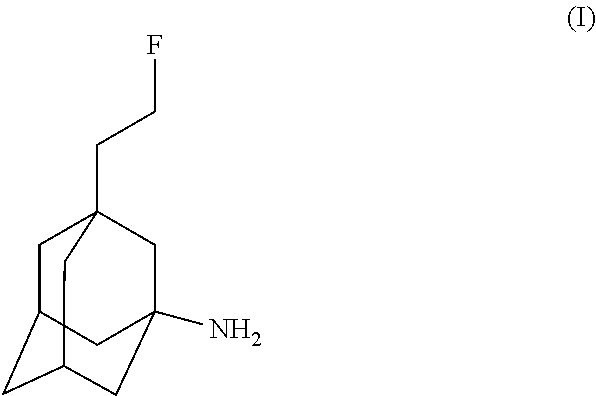Use of fluoroethylnormemantine for the prevention and treatment of anxiety
a fluoroethylnormemantine and anxiety technology, applied in the direction of nervous disorders, medical preparations, drug compositions, etc., can solve the problems of rapid decrease in concentration ability, loss of interest, and risk of anxiogenic
- Summary
- Abstract
- Description
- Claims
- Application Information
AI Technical Summary
Benefits of technology
Problems solved by technology
Method used
Image
Examples
embodiment 10
a component (C) comprising an antidepressant, in particular one of the serotonin reuptake inhibitors described in embodiment 10; wherein each of components (A) and (C) is formulated with at least one pharmaceutically acceptable excipient.
[0057]According to a particular embodiment of the product according to the invention, it is characterized in that it is devoid of schizophrenia-inducing effect.
[0058]In a fifteenth embodiment, the invention further relates to a product according to embodiment 13, further comprising in combination, a component (D) comprising ketamine formulated with a pharmaceutically acceptable excipient.
[0059]In a sixteenth embodiment, the invention further relates to a product according to embodiment 14, further comprising in combination, a component (D) comprising ketamine formulated with a pharmaceutically acceptable excipient.
[0060]In a seventeenth embodiment, the invention further relates to a product according to embodiment 13, in which components (A) and (B)...
example 1
reatment and Locomotor Activity
[0130]Open-field test: The locomotor activity of the animals and the “normal” anxiety associated with the discovery of an unknown environment are measured in an open field using a video monitoring system for 2 hours, 30 minutes after the injection of the solutions to be tested. The recorded data include, with a reading every 5 minutes, the time spent in the central squares, vertical activity, and the number of displacements.
[0131]Tables 1 to 3, below, report the effects of FENM.HCl, comparing memantine and a control saline solution.
[0132]
TABLE 1Mean time spent in the central squares per time interval (s)Animal group0-5 min5-10 min0-10 min0-120 minControl132.9104.9237.82293.4Memantine 10 mg / kg90.446.3136.81874.8FENM 5 mg / kg128.888.0216.81563.6FENM 10 mg / kg116.8109.9226.71803.8FENM 20 mg / kg129.8105.9235.71692.8
[0133]
TABLE 2Vertical activityAnimal group0-5 min5-10 min0-10 min0-120 minControl49.8326.5876.42115.33Memantine 10 mg / kg11.334.6716.0060.08FENM 5 ...
example 2
reatment (Light-Dark Box Paradigm)
[0136]In this example the light-dark box test was used. As it is based on rodents' innate aversion to light, the increase in time spent in the lighted compartment is therefore considered to reflect a lower level of anxiety.
[0137]The box used for this test is divided into a white behavior with high-power illumination (600 lux) and a black behavior with a lid (about 5 lux). The number of entries and the time spent in the illuminated compartment (anxiety zone) are recorded for 10 minutes by a video monitoring system. In addition, the system makes it possible to differentiate the periods between 0 and 5 minutes and between 5 and 10 minutes.
[0138]Table 4 below shows the presence times in the lighted compartment for different doses of FENM·HCl, comparing memantine and a control saline solution.
[0139]
TABLE 4Time spent in the lighted compartment (s)Animal group0-5 min5-10 min0-10 minControl34.137.071.1Memantine 1 mg / kg34.225.759.9Memantine 3 mg / kg26.28.134....
PUM
| Property | Measurement | Unit |
|---|---|---|
| time | aaaaa | aaaaa |
| time | aaaaa | aaaaa |
| volume | aaaaa | aaaaa |
Abstract
Description
Claims
Application Information
 Login to View More
Login to View More - R&D
- Intellectual Property
- Life Sciences
- Materials
- Tech Scout
- Unparalleled Data Quality
- Higher Quality Content
- 60% Fewer Hallucinations
Browse by: Latest US Patents, China's latest patents, Technical Efficacy Thesaurus, Application Domain, Technology Topic, Popular Technical Reports.
© 2025 PatSnap. All rights reserved.Legal|Privacy policy|Modern Slavery Act Transparency Statement|Sitemap|About US| Contact US: help@patsnap.com



